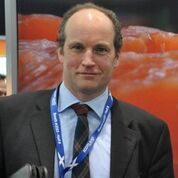SSPO welcomes bumper year

THE Scottish Salmon Producers’ Organisation has welcomed record production levels by salmon farmers in 2017.
In government figures just published, Scottish farms harvested 189,707 tonnes in 2017, up by 16.5 per cent on 2016 and the sector’s highest ever output.
The level of survival on farms has also improved, up to 79.1 per cent compared to 73.3 per cent in the previous year.
Gilpin Bradley (pictured), chairman of the SSPO, said: ‘2017 was a successful year for Scottish salmon farmers. Volumes were strong and exports reached an all-time high, with sales of £600 million to more than 50 countries worldwide.
‘This is testament to the hard work and commitment of so many dedicated salmon farmers in the Highlands and islands and the global recognition of Scottish salmon’s enviable premium market position.
‘Demand for quality Scottish salmon continues to outstrip supply and the sector aspires to grow to meet demand, but we also recognise the importance of steady, sustainable development.
‘These new figures, alongside the investment in tackling emerging challenges, give us great confidence in the sector’s ability for sustainable growth over the coming years.’
Salmon farming is significant to Scotland’s economy, with Highlands and Islands Enterprise (HIE) recently reporting that employment in the industry and the wider supply chain topped 10,000 full time equivalent jobs.
Charlotte Wright, chief executive of HIE, said: ‘These figures are good news for Scottish aquaculture and show the significant social contributions the industry makes to remote rural, island and coastal areas by supporting high-skilled jobs, diversifying and protecting communities.
‘Salmon farming is a major contributor to the Highlands and islands economy and brings additional business opportunities to the area.
‘We have supported the aquaculture industry since its inception and as a vital sector which provides many jobs for rural communities.’
Ahead of an anticipated dip in production in 2018, because of gill health issues during autumn 2017, which affected salmon due for harvest in 2018, the sector is putting investment in place to help smooth fluctuations in production.
There is an increased move towards the use of recirculated aquaculture systems to ensure the growth of more robust smolts, along with the installation of continuous environmental monitoring and other camera technology to closely monitor fish behaviour once at sea.
Bradley, who runs Wester Ross Salmon, added: ‘Salmon farmers have invested more than £60 million in new technologies and improved farming techniques, research projects and cleaner fish to remove naturally occurring sea lice which thrive in the warmer temperatures.
‘Farmers continue to work hard to improve fish health and salmon survival and we are seeing benefits coming from the new innovations.
‘It is encouraging to see that the report confirms an improvement in the industry’s survival figures as a result of the ongoing investment in this area.
‘Farmers are leading contributors to the Scottish government’s Farmed Fish Health Framework, the 10-year strategy for continued improvement in fish health and to encourage collaboration between industry, regulators and scientists.’
Investments in the sector include £105 million by Marine Harvest in its 170,000 tonne fish feed facility on Skye, due to open next year, and its proposed visitor centre.
Farm-by-farm reporting of sea lice levels, introduced this year, has shown that, on the whole, lice levels during 2018 are at a five-year low.

